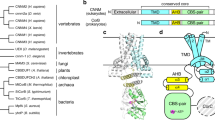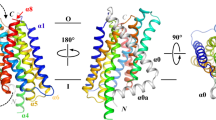Abstract
The Bacillus subtilis manganese transport regulator, MntR, binds Mn2+ as an effector and is a repressor of transporters that import manganese. A member of the diphtheria toxin repressor (DtxR) family of metalloregulatory proteins, MntR exhibits selectivity for Mn2+ over Fe2+. Replacement of a metal-binding residue, Asp8, with methionine (D8M) relaxes this specificity. We report here the X-ray crystal structures of wild-type MntR and the D8M mutant bound to manganese with 1.75 Å and 1.61 Å resolution, respectively. The 142-residue MntR homodimer has substantial structural similarity to the 226-residue DtxR but lacks the C-terminal SH3-like domain of DtxR. The metal-binding pockets of MntR and DtxR are substantially different. The cation-to-cation distance between the two manganese ions bound by MntR is 3.3 Å, whereas that between the metal ions bound by DtxR is 9 Å. D8M binds only a single Mn2+ per monomer, owing to alteration of the metal-binding site. The sole retained metal site adopts pseudo-hexacoordinate geometry rather than the pseudo-heptacoordinate geometry of the MntR metal sites.
This is a preview of subscription content, access via your institution
Access options
Subscribe to this journal
Receive 12 print issues and online access
$189.00 per year
only $15.75 per issue
Buy this article
- Purchase on Springer Link
- Instant access to full article PDF
Prices may be subject to local taxes which are calculated during checkout




Similar content being viewed by others
References
Jakubovics, N.S. & Jenkinson, H.F. Out of the iron age: new insights into the critical role of manganese homeostasis in bacteria. Microbiology 147, 1709–1718 (2001).
Horsburgh, M.J., Wharton, S.J., Karavolos, M. & Foster, S.J. Manganese: elemental defence for a life with oxygen. Trends Microbiol. 10, 494–501 (2002).
Pohl, E. et al. Architecture of a protein central to iron homeostasis: crystal structure and spectroscopic analysis of the ferric uptake regulator. Mol. Microbiol. 47, 903–915 (2003).
Boyd, J., Ooze, M.N. & Murphy, J.R. Molecular cloning and DNA sequence analysis of a diphtheria tox iron-dependent regulatory element (dtxR) from Corynebacterium diphtheriae. Proc. Natl. Acad. Sci. USA 87, 5968–5972 (1990).
Gold, B., Rodriguez, G.M., Marras, S.A.E., Pentecost, M. & Smith, I. The Mycobacterium tuberculosis IdeR is a dual functional regulator that controls transcription of genes involved in iron acquisition, iron storage and survival in macrophages. Mol. Microbiol. 42, 851–865 (2001).
Feese, M.D., Pohl, E., Holmes, R.K. & Hol, W.G.J. Iron-dependent regulators. In Handbook of Metalloproteins (eds. Messerschmidt, A., Huber, R., Poulos, T. & Wieghardt, K.) 850–863 (Wiley, Chichester, UK, 2001).
Ringe, D., White, A., Chen, S. & Murphy, J.R. Diphtheria toxin repressor: metal ion mediated control of transcription. In Handbook of Metalloproteins (eds. Messerschmidt, A., Huber, R., Poulos, T. & Wieghardt, K.) 929–938 (Wiley, Chichester, 2001).
Spiering, M.M., Ringe, D., Murphy, J.R. & Marletta, M.A. Metal stoichiometry and functional studies of the diphtheria toxin repressor. Proc. Natl. Acad. Sci. USA 100, 3808–3813 (2003).
Qiu, X. et al. Three-dimensional structure of the diphtheria toxin repressor in complex with divalent cation co-repressors. Structure 3, 87–100 (1995).
Feese, M.D., Ingason, B.P., Goranson-Siekierke, J., Holmes, R.K. & Hol, W.G.J. Crystal structure of the iron-dependent regulator from Mycobacterium tuberculosis at 2.0 Å resolution reveals the Src homology domain 3-like fold and metal binding function of the third domain. J. Biol. Chem. 276, 5959–5966 (2001).
White, A., Ding, X., van der Spek, J.C., Murphy, J.R. & Ringe, D. Structure of the metal-ion-activated diphtheria toxin repressor/tox operator complex. Nature 394, 502–506 (1998).
Pohl, E., Holmes, R.K. & Hol, W.G.J. Motion of the DNA-binding domain with respect to the core of the diphtheria toxin repressor (DtxR) revealed in the crystal structures of apo- and holo-DtxR. J. Biol. Chem. 273, 22420–22427 (1998).
Twigg, P.D., Parthasarathy, G., Guerrero, L., Logan, T.M. & Caspar, D.L.D. Disordered to ordered folding in the regulation of diphtheria toxin repressor activity. Proc. Natl. Acad. Sci. USA 98, 11259–11264 (2001).
Schmitt, M.P. Analysis of a DtxR-like metalloregulatory protein, MntR, from Corynebacterium diphtheriae that controls expression of an ABC metal transporter by an Mn2+-dependent mechanism. J. Bacteriol. 184, 6882–6892 (2002).
Posey, J.E. & Gherardini, F.C. Lack of a role for iron in the Lyme disease pathogen. Science 288, 1651–1653 (2000).
Que, Q. & Helmann, J.D. Manganese homeostasis in Bacillus subtilis is regulated by MntR, a bifunctional regulator related to the diphtheria toxin repressor family of proteins. Mol. Microbiol. 35, 1454–1468 (2000).
Guedon, E. et. al. The global transcriptional response of Bacillus subtilis to manganese involves the MntR, Fur, TnrA, and σB Regulons. Mol. Microbiol. in the press (2003).
Schmitt, M.P. & Holmes, R.K. Analysis of diphtheria toxin repressor-operator interactions and characterization of a mutant repressor with decreased binding activity for divalent metals. Mol. Microbiol. 9, 173–181 (1993).
Guedon, E. & Helmann, J.D. Origins of metal ion selectivity in the DtxR/MntR family of metalloregulators. Mol. Microbiol. 48, 495–506 (2003).
Brennan, R.G. The winged-helix DNA-binding motif: another helix-turn-helix takeoff. Cell 74, 773–776 (1993).
Wintjens, R. & Rooman, M. Structural classification of HTH DNA-binding domains and protein–DNA interaction modes. J. Mol. Biol. 262, 294–313 (1996).
Kanyo, Z.F., Scolnick, L.R., Ash, D.E. & Christianson, D.W. Structure of a unique binuclear manganese cluster in arginase. Nature 383, 554–557 (1996).
Bewley, M.C., Jeffrey, P.D., Patchett, M.L., Kanyo, Z.F. & Baker, E.N. Crystal structures of Bacillus caldovelox arginase in complex with substrate and inhibitors reveal new insights into activation, inhibition and catalysis in the arginase superfamily. Structure 7, 435–448 (1999).
Wilce, M.C.J. et al. Structure and mechanism of a proline-specific aminopeptidase from Escherichia coli. Proc. Natl. Acad. Sci. USA 95, 3472–3477 (1998).
Barynin, V.V. et al. Crystal structure of manganese catalase from Lactobacillus plantarum. Structure 9, 725–738 (2001).
Glusker, J.P., Katz, A.K. & Bock, C.W. Two-metal binding motifs in protein crystal structures. Struct. Chem. 12, 323–341 (2001).
Whittington, D.A. & Lippard, S.J. Crystal structures of the soluble methane monooxygenase hydroxylase from Methylococcus capsulatus (Bath) demonstrating geometrical variability at the dinuclear iron active site. J. Am. Chem. Soc. 123, 827–838 (2001).
Atta, M., Fontecave, M., Wilkins, P.C. & Dalton, H. Abduction of iron(III) from the soluble methane monooxygenase hydroxylase and reconstitution of the binuclear site with iron and manganese. Eur. J. Biochem. 217, 217–223 (1993).
Harding, M.M. The geometry of metal-ligand interactions relevant to proteins. II. Angles at the metal atom, additional weak metal-donor interactions. Acta Crystallogr. D 56, 857–867 (2000).
Kim, N.N. et al. Probing erectile function: S-(2-boronoethyl)-L-cysteine binds to arginase as a transition state analogue and enhances smooth muscle relaxation in human penile corpus cavernosum. Biochem. 40, 2678–2688 (2001).
Seemann, J.E. & Schultz, G.E. Structure and mechanism of L-fucose isomerase from Escherichia coli. J. Mol. Biol. 273, 256–268 (1997).
Leslie, A.G.W. Recent changes to the MOSFLM package for processing film and image plate data. Joint CCP4 + ESF-EAMCB Newsletter on Protein Crystallography Vol. 26 (Daresbury Laboratory, Warrington, UK, 1992).
Brunger, A.T. et al. Crystallography & NMR System: a new software suite for macromolecular structure determination. Acta Crystallogr. D 54, 905–921 (1998).
Yeates, T.O. Detecting and overcoming crystal twinning. Methods Enzymol. 276, 344–358 (1997).
Laskowski, R.A., MacArthur, M.W., Moss, D.S. & Thornton, J.M. PROCHECK: a program to check the stereochemical quality of protein structures. J. Appl. Crystallogr. 26, 283–291 (1993).
Acknowledgements
We thank M.A. Schumacher for help with data collection and K.J. Newberry for assistance with refinement and model building. This work was supported in part by the Oregon Medical Research Foundation (A.G.) and grants from the US National Institutes of Health (NIH) (R.G.B. and J.D.H.). Portions of this research were carried out at the Stanford Synchrotron Radiation Laboratory (SSRL), operated by Stanford University on behalf of the US Department of Energy (DOE), Office of Basic Energy Sciences. The SSRL Structural Molecular Biology Program is supported by the DOE, Office of Biological and Environmental Research, and by the US NIH, National Center for Research Resources, Biomedical Technology Program, and the National Institute of General Medical Sciences.
Author information
Authors and Affiliations
Corresponding authors
Ethics declarations
Competing interests
The authors declare no competing financial interests.
Rights and permissions
About this article
Cite this article
Glasfeld, A., Guedon, E., Helmann, J. et al. Structure of the manganese-bound manganese transport regulator of Bacillus subtilis. Nat Struct Mol Biol 10, 652–657 (2003). https://doi.org/10.1038/nsb951
Received:
Accepted:
Published:
Issue Date:
DOI: https://doi.org/10.1038/nsb951
This article is cited by
-
Progress in comprehensive utilization of electrolytic manganese residue: a review
Environmental Science and Pollution Research (2023)
-
Conformational studies of the manganese transport regulator (MntR) from Bacillus subtilis using deuterium exchange mass spectrometry
JBIC Journal of Biological Inorganic Chemistry (2007)
-
Structural Determinants of Metal Selectivity in Prokaryotic Metal-responsive Transcriptional Regulators
BioMetals (2005)



